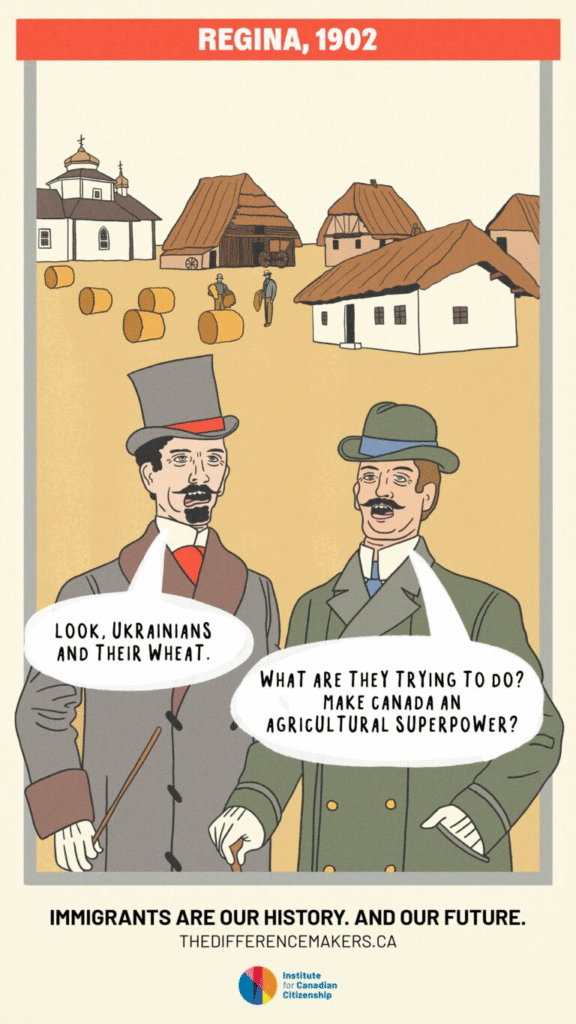This article was originally published on the Population Institute Canada website (populationinstitutecanada.ca) on October 30th, 2025. It is republished here with permission of the author.
When I look at the accelerating mess that is Canada, I am reminded of the answer by a character in Ernest Hemingway’s novel The Sun Also Rises, who was asked how he went bankrupt. “Two ways,” he replies. “Gradually and then suddenly.”
That answer, it seems to me, might apply to the question, “How was Canada destroyed?” It feels like we’ve arrived at the “suddenly” part.
The increasing dysfunction of Canada is the subject of Tristin Hopper’s book, Don’t be Canada: How One Country Did Everything Wrong All At Once. Amazon’s description provides a nice summary:
“Drawing from real headlines, deep research, and extensive interviews, acclaimed journalist Tristin Hopper uncovers the bizarre missteps and policy experiments that have helped Canada set new global standards for dysfunction. The examples are legion: the real estate bubble that never bursts, Orwellian internet regulations, harm reduction policies that escalate harm, official health guidelines that recommended the use of glory holes in a pandemic, and a runaway euthanasia system that inspired the Wall Street Journal to declare, ‘Welcome to Canada, the Doctor Will Kill You Now.’
As sobering as it is comic, Don’t Be Canada examines the cascading consequences of extreme policies and tells the tragic story of a country that took its wealth, tolerance, and functionality for granted.“
One of those extreme policies pertains to immigration. Massive rapid population growth deliberately achieved through a reckless immigration system is a primary driving force behind the current immiseration of Canadians. While Justin Trudeau shovelled coal into the firebox of a runaway steam engine, the first to start disabling the brakes was Conservative Prime Minister Brian Mulroney and no one has really fixed them since.
When it comes to immigration, Canada has a “Uniparty”
In 1990, Mulroney’s immigration minister Barbara McDougall won a major cabinet battle when she succeeded in raising Canada’s target for immigration to 250,000 annually, regardless of economic conditions. Prior to that time, the number of new immigrants to Canada had varied from year to year, depending on perceived economic conditions.

McDougall would have known that her arguments for the alleged economic benefits of uninterrupted high immigration were on shaky ground given that immigrants who had come to Canada since 1978, when the family class was introduced, were less educated, less able to speak English or French, and had dramatically lower earnings that their predecessors. But she also mentioned a more credible reason for the change in policy – a new source of voters for the Conservative party.

Brian Mulroney’s successors, regardless of political party, maintained the annual target of 250,000, using the same bogus economic arguments. Of course, they too had an eye on the immigrant vote. And likely on the people who actually benefitted from mass immigration, such as bankers, real estate developers, and cheap labour employers, who could perhaps be counted on for political donations and other kinds of rewards.
So, despite warning signs both economic and social, not to mention the environmental impact and tremendous loss of farmland, Barbara McDougall’s high target was followed by Liberals Jean Chrétien and Paul Martin, and Conservative Stephen Harper. (Kim Campbell was not in office long enough to be held responsible for any policy.)
A scam perpetuated through an enforced “consensus”
Contrary to what we consistently hear from the mainstream media, there was never a “consensus” on immigration. The Mulroney government never consulted working Canadians, the losers in McDougall’s scam. Instead they were subjected to relentless propaganda about the benefits of immigration, a mythological history in which high levels of immigration each and every year had always been the norm, and the deification of multiculturalism. Mulroney even introduced a Multiculturalism Act. Canada was presented as having the unique ability to integrate anyone from anywhere in the world. Advocacy of more moderate levels of immigration or concerns about integration were sidelined as racist, xenophobic, and anti-immigrant or even as cover for darker motives.
Even someone with the stature of David Suzuki (full disclosure: he is a PIC patron), was not safe in mentioning the environmental consequences of immigration. He triggered the outrage of Jason Kenney, Stephen Harper’s immigration minister, in a July 1, 2013, interview with the Parisian magazine l’Express, in which he criticized Canada’s immigration policy while on a speaking tour in Australia.
The French interviewer, Jean-Michel Demetz, said that Australian environmentalists were opposed to population growth, which was primarily due to immigration, and that they claimed that Australia was full. Suzuki agreed and said that Canada was also full:
“Oh, I believe that Canada is full too! Even though it’s the second largest country in the world, our useful area is small. Our immigration policy is sickening: we pillage countries of the South and deprive them of their future leaders and we want to increase our population in order to increase growth of our economy. It’s nuts.”
In response, Kenney savaged Suzuki on Twitter for having views that are “toxic and irresponsible” and “stridently anti-immigration.”
Suzuki’s sin was not in saying anything that was false. It was in challenging the so-called consensus. Kenney did not acknowledge another comment by the allegedly “stridently anti-immigration” Suzuki in the same interview:
“That doesn’t mean that we have no responsibility towards those who have difficulty surviving elsewhere. But there is no more room. All the same, Canada should always open its doors to those who suffer from oppression or crisis. During the 1970s, when we took in 50,000 boat people from Vietnam, I was particularly proud of being a Canadian.”
Perhaps we should not be so surprised then at the silence of environmental organizations about the impact of Canada’s population growth on the environment.
And then the Dauphin blew the lid off
It took Justin Trudeau to break the alleged consensus that had kept Canadians compliant with the immigration scam for so long. He did this by raising the intake of all categories of newcomer to the point of creating a severe housing crisis, homeless crisis, food crisis and general affordability crisis, such that 70% of Canadians agreed with Conservative opposition leader Pierre Poilievre that “Canada is broken.”
In October 2017, two years after Trudeau was first elected as prime minister, his immigration minister Ahmed Hussen announced a “new normal” of 300,000 newcomers annually, a target that would be raised one year later to 350,000 by 2021. While Covid put a damper on those plans in 2020, the number rebounded in 2021. In November 2022, Hussen’s successor Sean Fraser said that Canada had welcomed 405,000 newcomers during the previous year and announced targets of 465,000 to 500,000 for 2023 to 2025. These targets were reiterated by his successor, Mark Miller, the following year.
While the number of immigrants, that is to say new permanent residents to Canada, was being ramped up, the numbers of temporary foreign workers (not included in the above-mentioned targets) was rising even more sharply, and the numbers of international students and asylum seekers were also soaring.
As a result, Canada’s population grew by 1.05 million in 2022. In 2023, it grew by 1.27 million, with 97.6% of the growth coming from international migration and only 2.4% from natural increase.
Trudeau turned a bad policy into a disaster. With poll after poll showing that Canadians were turning sour on immigration, his government went into damage control, lowering the targets of permanent residents and capping the number of temporary workers and international students. And after a decade of laxity in evaluating asylum claims, Canada is now seeking to reduce the number of claims through various measures.
Laying the groundwork – the “gradually” part of Canada’s destruction
While Justin Trudeau’s tenure as prime minister represents the “suddenly” part of Canada’s journey from riches to rags, the impetus to put Canada’s growth into overdrive through mass immigration preceded his coming to power. Trudeau’s “suddenly” policies must be viewed in the context of the “gradually” part that set the stage for him. The enforced “consensus” on perpetually high immigration was part of this effort. It served not only the financial interests of the profiteers of growth, but also those of globalist powerbrokers. Canada, as Trudeau himself said shortly after becoming prime minister, was to be the first “postnational” state.
The most obvious villain in this saga is the Century Initiative, which I have excoriated on more than one occasion. In 2009, an organization called the Laurier Project was founded by Dominic Barton and Mark Wiseman, with the stated objective of bringing Canada to a position of global leadership through a major initiative. That major initiative turned out to be a massive increase in population, because in 2011 the same two people co-founded its successor, the Century Initiative, with the explicit purpose of reaching a Canadian population of 100 million by 2100. The Century Initiative has become much cagier about its objective now that Canada’s social and economic deterioration is raising long overdue questions about its activities, as is evident when one compares its current website with earlier versions, such as this web-archived version from February 2017.
Both of the Century Initiative’s co-founders have solid globalist connections. Both are members of the World Economic Forum (WEF), an organization promoting global governance. Dominic Barton worked for 33 years with the US consultancy firm McKinsey and Company and was Global Managing Partner when he left it in July 2018. Mark Wiseman was President and CEO of the Canada Pension Plan Investment Board at the time he co-founded the Century Initiative, later holding very senior positions at the investment management company BlackRock for many years. Unsurprisingly, the Century Initiative counts banks and corporations, as well as “stakeholders” in the immigration industry, among its funders.
It was Dominic Barton who introduced the recently elected Prime Minister Trudeau to World Economic Forum’s in-crowd at its January 2016 meeting in Davos. Within months of Trudeau’s coming to power, his government established an Advisory Council on Economic Growth, chaired by Barton with Mark Wiseman as one of its members. As one might expect, the Advisory Council’s reports advocated for large increases in immigration. In August 2018, one month after Barton left McKinsey, the firm received the first in a series of lucrative contracts with Immigration, Refugees, and Citizenship Canada (IRCC), leading to credible allegations that it was heavily involved in setting policies there.
The Century Initiative’s agenda was also pushed by the mainstream media. Even prior to its creation in 2011, the idea of 100 million was promoted in the 2010 Spring/Summer issue of Global Brief in an article by Irvin Studin called Canada – Population 100 Million. Studin is the founder and publisher of Global Brief magazine, president of the Institute for 21st Century Questions, and is listed under “people” by the Centre for International Governance Innovations (CIGI). His article was republished under variants of the title in many newspapers in Canada.
Numerous other articles and at least one book promoting the idea were published over the years. A far from exhaustive sampling is shown below:
- Fulfilling Laurier’s vision: a Canada of 100 million, by Robert Kaplan. Globe and Mail, 21 July 2011.
- Why Canada needs a flood of immigrants, by Joe Friesen. Globe and Mail, 4 May 2012.
- Let’s strive for that 100 million, by Andrew Coyne. Ottawa Citizen, 29 October 2016.
- Maximum Canada: Why 35 million Canadians are not enough (book), by Doug Saunders. Knopf, Sept 2017.
- Five pivots to Canada’s success in the post-COVID-19 period, by Irvin Studin. Ottawa Citizen, 2 May 2020. (Pivot #2 was 100 million by 2100)
- It’s time for Canada to focus on expanding our population, by John Ibbitson. Globe and Mail, 31 March 2021.
- Immigration will help Canada build back better, but only if the country has all hands on deck, by Lisa Lalande and Goldy Hyder, Globe and Mail, 28 December 2021.
- The Case for 100 Million Canadians, by Adnan R. Khan, The Walrus, 2 April 2025.
The idea has also been promoted on radio and TV. It’s almost as if the stage were being set for the torrent that Trudeau was to unleash. During his term as prime minister, from November 2015 to January 2025, Canada’s population mushroomed from 35.9 million to 41.5 million.
Was Trudeau’s mission to change Canada from a country to a postnational state?
Since 2021, the Globe and Mail, several of whose columnists have been advocates of the 100 million objective, has hosted a webinar by the Century Initiative. Brian Mulroney, who first implemented the policy of a perpetually wide-open gate, was a supporter of the organization and spoke at the inaugural webinar in 2021. Mark Carney, who was Trudeau’s economic advisor during and after Covid, spoke at the 2024 event.
Interestingly, Chrystia Freeland, who long served as Justin Trudeau’s finance minister and deputy prime minister, is pictured under “Our Board & Advisors – Working Towards Canada’s Century” on the archived site about the Laurier Project, the Century Initiative’s predecessor. Trudeau still is and Freeland was a member of the World Economic Forum. Freeland was appointed as a WEF trustee in January 2019, a position also held by Mark Carney at the time. Both Trudeau and Freeland are also graduates of WEF founder and long-serving chairman Klaus Schwab’s Young Global Leaders program. During a September 2017 interview at Harvard University’s Kennedy School of Government, Schwab boasted that young leaders such as Trudeau supported the WEF which, he said, “penetrates the cabinets” of their countries.

Trudeau’s actions as prime minister align with turning Canada from a country into a geographic location in a globalized world. On the very day that he was first sworn in as prime minister, November 4, 2015, the name of the department previously known as Foreign Affairs, Trade and Development Canada was changed to Global Affairs Canada. That same month, he told New York Times magazine that “There is no core identity, no mainstream in Canada.” Much of what Trudeau said and did as prime minister seemed designed to disparage and erase Canada’s history.
Under Trudeau’s leadership, Canada would take a lead role in promoting international agreements that could be seen as weakening the sovereignty of nation states in favour of supranational organizations, such as the United Nations Global Compact on Safe, Orderly and Regular Migration that enables the free flow of migrants across borders, and the World Health Organization’s Pandemic Agreement that through its International Health Regulations empowers the WHO to set policies during pandemics, and as delegitimizing nations like Canada that were founded by Europeans, such as the UN Declaration on the Rights of Indigenous Peoples (UNDRIP).
An interview presaging a postnational Canada
Trudeau signalled his globalist leanings long before he became prime minister or even sat in Parliament. In an October 2006 interview with Seamus O’Regan, he belittled the idea of “a nation”. The subject of the interview was a recently published biography of Trudeau’s father, Citizen of the World: The Life of Pierre Elliott Trudeau, by Professor John English, but in closing the discussion O’Regan asked Trudeau’s opinion on the debate within the Liberal Party about Quebec nationalism. It was ignited when Michael Ignatieff, the frontrunner in the leadership race for the party (following Conservative Stephen Harper’s win in the federal election that year), said he supported a resolution by the Quebec wing of the Liberal Party that recognized Quebec as a nation.
“…the one thing that comes through this book clear as day is the evolution of my father’s thought away from nationalism towards a bigger view of Canada and of Quebec’s role in it than folding back on this idea of a nation. It’s an old idea from the 19th century. It’s something that is not relevant to the vibrant extraordinary culture that is Quebec as being such an amazing part of Canada. Nationalism is based on a smallness of thought that closes in, that builds up barriers between peoples and has nothing to do with the Canada we should be building. We need to start looking forward and unfortunately, some people these days are wrapped up in this idea of nation for Quebec, which stands against everything my father ever believed,” Trudeau said, before clarifying that his father’s thinking had evolved to that position.
O’Regan then comments with a chuckle, “Very interesting. I’m reading between the lines right now.” Trudeau smiles and says, “I’m supposed to be sort of quiet on this,” as he makes a quick motion with his hands, as if brushing something aside, “but this book really is a book that people should be reading now.”

In hindsight, one could say that in 2006 Trudeau was letting the cat out of the bag about his “bigger view of Canada…than folding back on this idea of a nation.” His declaration in 2015 of Canada being the first “postnational state” was aspirational. During the next 10 years, it seems he did everything he could to make it so through the mass immigration of people from every country and every culture.
Many organizations promoting one message with government funding
While Canadians were never consulted in any meaningful way about their government’s immigration policies, they were subjected to a great deal of propaganda, overt and subliminal, to forge what was called a “consensus.” The role of the media in pushing it and the risks involved in opposing it were discussed above. The “consensus” was also promoted by government agencies and non-governmental organizations, some of which received government funding. Even Statistics Canada was recruited into producing propaganda instead of analysis, with a superficial and downright embarrassing video to celebrate the milestone of 40 million on June 16, 2023.
Not long after the Trudeau government announced its intention to ramp up immigration, it started a social marketing campaign targeting the approximately 60% of Canadians deemed to be neither strongly for nor against immigration. Canadians, it seems, even if they accepted that immigration was good nationally, were less likely to think that it benefitted them personally, in their communities. Therefore in November 2018 IRCC launched the “Immigration Matters” initiative, which involved “compelling storytelling to appeal to Canadians on an emotional level.” The IRCC sought “partners” to amplify its message, stating that the hotel, restaurant, and sports industries had been most receptive. The IRCC provided a “toolkit” to help “stakeholders” get the message out.
The charitable organization COSTI (established in 1952 to help Italian immigrants) seems to have participated in that effort. Among the ads shown on the electronic display board at Toronto’s Pearson International Airport (on 19 June 2019), COSTI presented a series of stylized images of “new Canadians” with a link that would tell you their story. COSTI’s mission is to “empower people from diverse communities to succeed and achieve their full potential by providing educational, employment, and social services.” Its primary funder (~53%) for the year ended March 31,2025, was the City of Toronto ($47,439,000 out of $89,800,00), followed by the federal government (~29% at $25,787,000), and the province of Ontario (~6% at $5,343,000).

The Institute for Canadian Citizenship advocates “for a more inclusive Canada through research, insights and live events” and claims to fight against misinformation and disinformation about immigration. Its 2024-2025 annual report shows that 55% ($2,764,533) of its total revenue ($5,015, 945) comes from government funding. Several banks and corporations are among its other top donors. The Century Initiative is a donor at the $1000+ (but lower than $5000) level.
The Institute for Canadian Citizenship shares a registered charity number with and has the copyright for an organization called the Difference Makers. The Difference Makers, identified as “a campaign” by the Institute for Canadian Citizenship, can be viewed as its “military wing,” mocking the know-nothing rubes who have concerns about immigration. On its website, it presents four posters introduced in large red uppercase letters with the question, “SEEN THE POSTERS?” Below that the text reads, “For centuries, immigrants have helped Canada overcome its greatest challenges. We’d do well to remember that before blaming immigrants for all that ails us.” Three of the posters show truly imbecilic-looking people disparaging various ethnicities at different times in history and the fourth shows similarly looking imbeciles blame immigrant nurses for clogging up the ER. Two are shown below.
The Institute for Canadian Citizenship is a charitable organization funded primarily by the Canadian government to promote its propaganda, with a “military wing” to promote the message that only xenophobic imbeciles raise questions about immigration. It irritates me that I’m forced to help pay for this through my taxes.


Canada’s immigration disaster: a bug or a feature?
The Canadian immigration industry is a growth machine that has long since stopped working for the benefit of ordinary working Canadians. Canada’s broken immigration system has contributed to a Canada where equality levels are rapidly falling and the 100 richest CEOs earn 210 times as much as the average worker.
And it’s not working for immigrants either. A 2024 Ipsos study conducted with the Institute of Canadian Citizenship found that 26% of newcomers reported that they were somewhat or very likely to leave Canada within two years. The number was higher (30%) for those who had already spent 5 or more years in Canada. The top three reasons for wanting to leave were economic: housing costs, low salary/income, and concerns about the economy generally. Fifty-one percent of newcomers said that Canada fell short of their expectations. This might explain why 27,086 citizens and permanent residents and 209,400 non-permanent residents left the country in the first quarter of 2025.
And yet, economic arguments continue to be used to justify mass immigration. The guiding mantra of the immigration industry seems to be that doing more of what has been driving Canada into decline will fix things.
All of which raises the question: Was Tristin Hopper right that Canada did everything wrong all at once – or was “doing everything wrong” in specific policy areas part of the plan to make Canada a postnational country that rewards certain financial elites and implements a globalist agenda?
Madeline Weld, Ph.D.
President, Population Institute Canada
Tel: (613) 833-3668
Email: mail@populationinstitutecanada.ca
www.populationinstitutecanada.ca
All content on this website is copyrighted, and cannot be republished or reproduced without permission.
Share this article!





Madeline Weld hits the ball out of the park once more.
It’s just to bad such a small percentage (my hunch) of my Canadian friends and neighbours do not get the message.
I find it ironic that David Suzuki in one breath suggests that the Conservative government of the day was increasing the population to grow the economy, then when responding to Jason Kenney’s wrath chided the Cons for promoting the oil sands – the very commodity behind immigration and pretty well everything else David Suzuki and the rest of the worlds population in 2025 enjoy. Take oil out of this life and you instantly slip back to 1859. That cannot be contested.
If there’s anyone in the orbit who thinks immigration the way it is handled in Canada and America isn’t having extreme negative effects on just about everything you can name, you only need to check out a recent Kris Sims interview where she sites an Edmonton teacher fed up with the strike ( now over) where she returned to her Grade 11 English class and 38 students – 16 of whom can’t speak English or have “severe learning disabilities ” Could not being able to speak the language of the country you reside result in a learning disability among other troubles? I think so.
Not much has changed since the Lying Brain days of 1978 sited by Ms. Weld who says the then immigration policy was “on shaky ground” . No, nothing has changed! Over the decades in fact we’ve quad tripled immigration since the days of immigration minister Barbie McDougal and the Cons, who served immigrants up in silver armour to the Canadian public. Today surreal public debt, class rooms coast to coast, hospitals wait times coast to coast , housing coast to coast and a host of other missteps we as Canadian taxpayers do not deserve – reflects the tragedy.
Another thought to be bounced off David Suzuki’s comment that Canada pillages other countries “of their future leaders” to grow the economy. How that statement could have been taken seriously then or now baffles the mind. The Canadian National debt is the highest it has ever been. Housing education, health care and you name it have been in the tank for decades, and to suggest that this country pillages others of future leaders – the result is grows the economy is spurious of the highest order.
The best most concise explanation of what really drives immigration I’ve found recently is the narrative contained in Ken LaCorte’s -Elephant in the room – YouTube channel video “Why did the elites open America’s Border”. Substitute “American” in that title for “Canadian” – and you’ll find just the players change!
The good thing is that more and more Canadians are waking up to the mass immigration Ponzi scheme – support for immigration restriction has returned to levels last seen in the ’80s and ’90s. What we need to remind Canadians is that mass immigration is ultimately driven by business interests and serves to enrich those interests at the expense of all Canadians of every race.